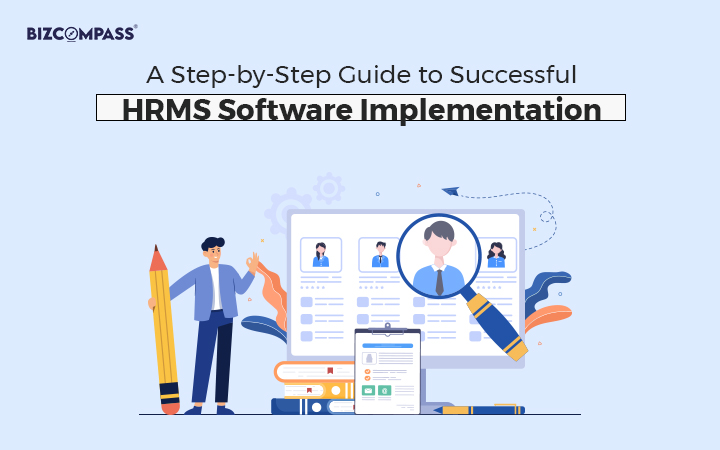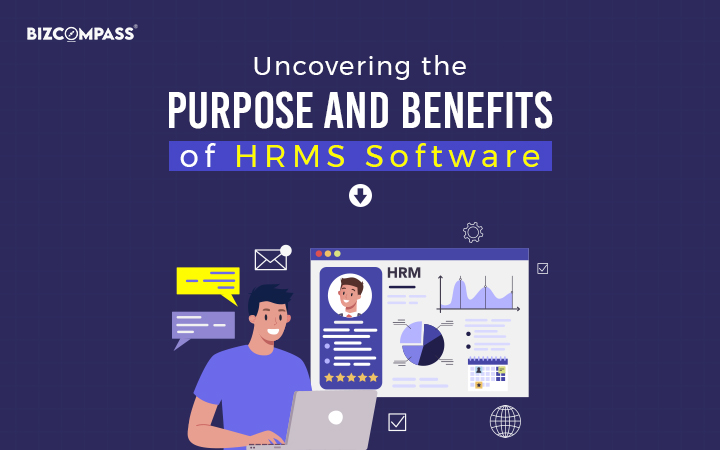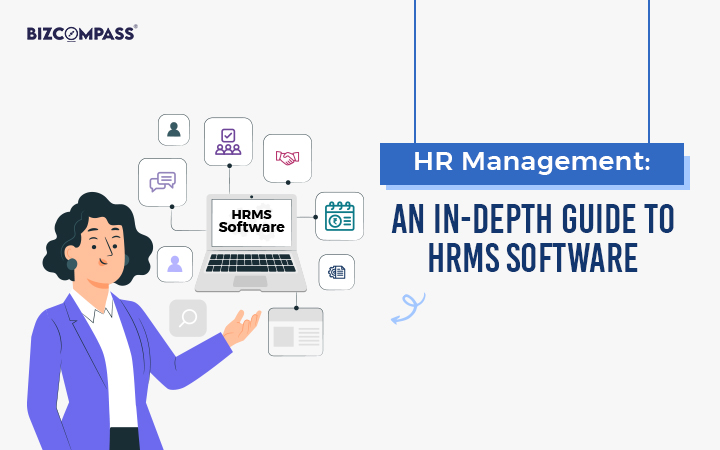Content
- Introduction
- Understanding Employee Data Privacy
- Ensuring Data Security In HRMS Software
- Role-Based Access Control (RBAC)
- Data Encryption Methods
- Multi-Factor Authentication (MFA)
- Cloud Security Measures
- Employee Training For Data Security
- Managing Third-Party Access
- Secure Data Transmission
- Auditing And Monitoring
- Incident Response And Data Breach Management
- Legal And Compliance Aspects
- Privacy By Design Principles
- Conclusion
- Faq
Introduction
In today's digital age, where the seamless management of human resources is imperative, Human Resource Management Systems (HRMS) have emerged as pivotal tools.
This blog delves into the critical realm of how HRMS software prioritizes the paramount concerns of employee data privacy and security. As organizations transition towards digital ecosystems for workforce management, safeguarding sensitive information becomes a non-negotiable priority.
We will explore the advanced features and protocols embedded in HRMS software, providing a comprehensive understanding of the robust mechanisms employed to ensure the confidentiality, integrity, and availability of employee data. From encryption protocols to access controls, this discussion aims to shed light on the proactive measures adopted by HRMS solutions to foster a secure and trustworthy environment for both employees and organizations alike.
Join us on this exploration of the intersection between technology and human resources, where data protection takes center stage in shaping the future of a resilient and responsible workplace.
Understanding Employee Data Privacy
Employee data privacy encompasses the ethical and legal protection of personal information belonging to workers within an organization. It involves securing sensitive details such as addresses, financial data, and performance metrics from unauthorized access or misuse. Upholding employee data privacy ensures trust, transparency, and compliance with data protection regulations.
Companies must implement robust measures, including encryption, access controls, and employee awareness programs, to safeguard this information. Respecting and prioritizing employee data privacy fosters a secure work environment, promotes organizational integrity, and builds confidence among staff members regarding the responsible handling of their data. Legal regulations like GDPR (General Data Protection Regulation) and CCPA (California Consumer Privacy Act) establish stringent guidelines for data privacy, mandating organizations to safeguard personal information.
Non-compliance can lead to severe consequences, including hefty fines and reputational damage. In the event of data breaches or privacy violations, companies face financial penalties and legal actions.
Beyond the financial implications, the loss of customer trust and damaged brand reputation are profound. Adhering to these regulations is imperative not only for legal compliance but also to preserve customer confidence and uphold the fundamental right to privacy in the digital age.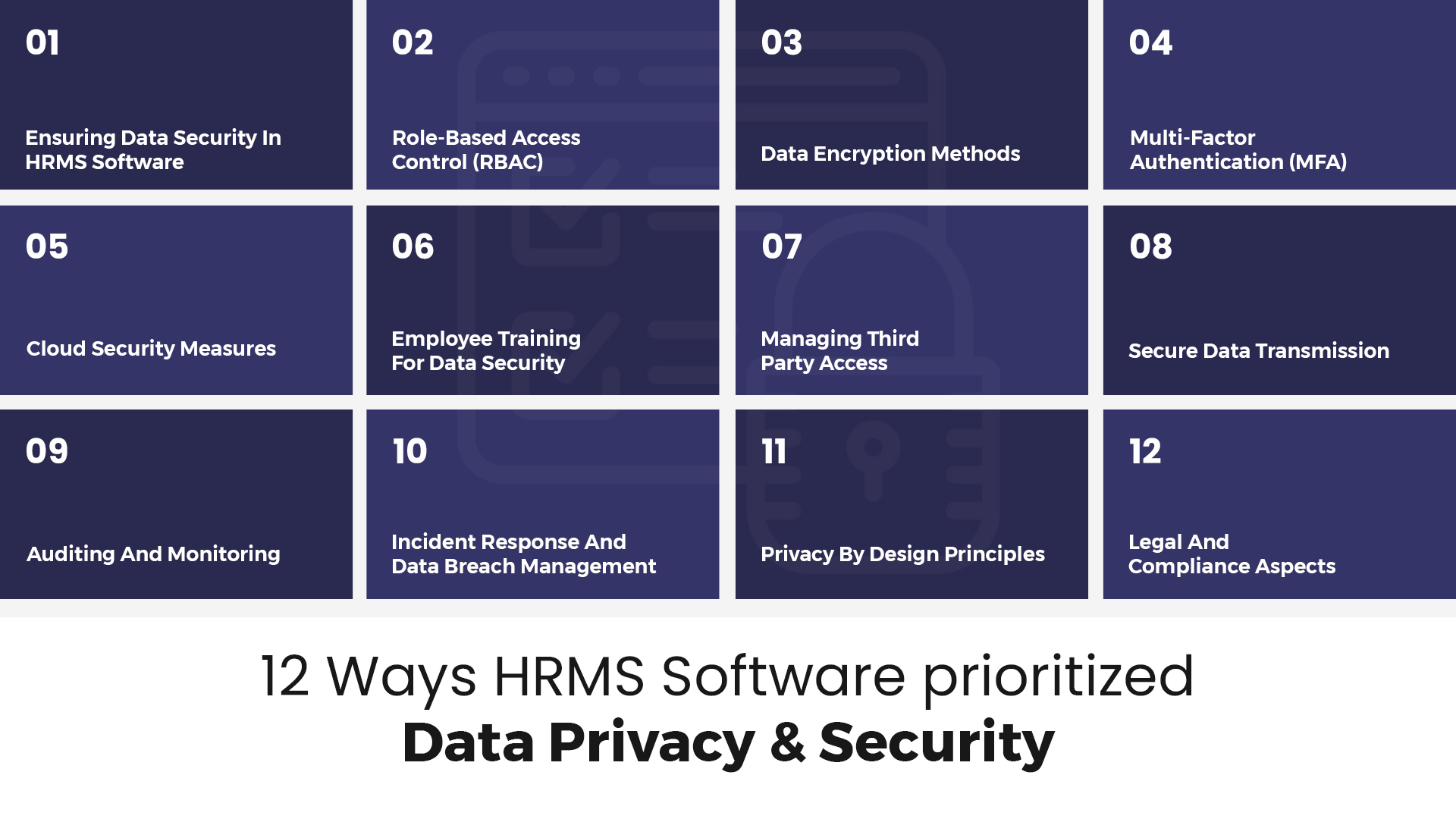
Ensuring Data Security In HRMS Software
Ensuring data security in HRMS software is paramount to protect sensitive employee information. Robust user authentication and access control mechanisms form the first line of defense, ensuring that only authorized personnel can access specific data. Implementing encryption techniques, such as encrypting data at rest and in transit, adds an extra layer of protection against unauthorized access
Regular security audits are essential to identify vulnerabilities and assess the overall resilience of the HRMS software. These audits help in proactively addressing potential threats and ensuring compliance with evolving security standards. Regular software updates and patches are crucial to patching vulnerabilities and staying ahead of emerging security risks. Moreover, user education and awareness programs play a crucial role in maintaining a secure HRMS environment.
Training employees to recognize phishing attempts, use strong passwords, and follow security best practices enhances the security posture. By integrating these measures into HRMS, organizations can foster a secure digital environment, instilling confidence in employees that their sensitive data is handled with the utmost care and that compliance with data protection regulations is a top priority.
Role-Based Access Control (RBAC)
Role-Based Access Control (RBAC) is a crucial security strategy implemented in HRMS software to enhance data protection. This approach restricts access to information based on an individual's role within the firm, ensuring that employees only have access to the data necessary for their responsibilities.
By assigning roles and associated access levels, organizations can finely tailor permissions, limiting the exposure of sensitive information to only those who require it for their job functions.
For instance, HR managers may have access to a broader set of employee data than regular employees, while IT administrators may have additional access rights for system configurations.
Implementing RBAC simplifies the management of access controls, as permissions are assigned based on job roles rather than individual identities. This not only streamlines the onboarding and offboarding processes but also mitigates the risk of unauthorized access. It's an effective means of enforcing the principle of least privilege, enhancing data security, and minimizing potential points of exploitation.
In the dynamic landscape of HRMS, RBAC serves as a cornerstone in fostering a secure and efficient data management system, aligning access permissions with organizational hierarchies and responsibilities.
Data Encryption Methods
Encryption methods are applied both at rest and in transit to mitigate the risk of unauthorized access and protect data integrity. At rest, encryption involves securing data stored on servers, databases, or other storage devices. This prevents unauthorized access to sensitive information even if physical access to the storage medium is compromised. In transit, encryption ensures that data remains confidential during transmission between different systems or when accessed remotely.
This is particularly crucial for securing information as it travels over networks, such as the Internet or internal communication channels. Key management is an integral aspect of encryption. It involves securely generating, distributing, and storing cryptographic keys used for encryption and decryption processes. Effective key management is essential to prevent unauthorized access to encrypted data.
Various encryption algorithms, such as Advanced Encryption Standard (AES) and RSA (Rivest–Shamir–Adleman), are employed to convert readable data into an unreadable format, making it indecipherable to unauthorized entities. The selection of encryption algorithms depends on factors like security requirements, computational efficiency, and industry standards. By implementing robust encryption methods, HRMS software ensures a secure environment for storing and transmitting sensitive employee data, contributing to overall data privacy and compliance with regulatory standards.
Multi-Factor Authentication (MFA)
MFA adds an extra layer of protection beyond traditional username and password combinations, requiring users to provide multiple forms of identification before gaining access.
The strength of MFA lies in its ability to authenticate users through a combination of factors, commonly categorized as "something you know" (password), "something you have" (a physical device or token), and "something you are" (biometric data). Various MFA methods include biometric authentication, where users are verified based on unique physical traits like fingerprints or facial recognition.
SMS-based MFA involves sending one-time codes to registered mobile devices. App-based MFA utilizes authenticator apps that generate time-sensitive codes for login verification.
Implementing MFA in HRMS software significantly reduces the risk of unauthorized access, as even if login credentials are compromised, an additional layer of authentication adds a formidable barrier.
This is particularly crucial when dealing with sensitive employee data and maintaining compliance with data protection regulations. By offering a diverse range of MFA methods, HRMS software accommodates user preferences and organizational security policies, providing a flexible yet robust approach to safeguarding access and ensuring the confidentiality and integrity of employee information.
Cloud Security Measures
Securing HR data in the cloud demands stringent measures. Robust encryption protocols are essential for data at rest and in transit, safeguarding sensitive information from unauthorized access.
Regular security assessments of cloud vendors ensure compliance with industry standards and regulations, validating the integrity of the chosen cloud infrastructure. By implementing multi-factor authentication, organizations add an extra layer of access security.
Continuous monitoring, intrusion detection systems, and automated alerts further fortify the cloud environment, enabling proactive responses to potential threats. These comprehensive measures collectively contribute to a secure cloud ecosystem for storing and managing HR data effectively.
Employee Training For Data Security
Educating employees on data security within HRMS is paramount for safeguarding sensitive information. It instills awareness of potential threats, such as phishing or unauthorized access, fostering a security-conscious workplace culture. Regular training sessions empower employees to recognize and respond to security risks, reducing the likelihood of human error.
By understanding the importance of password hygiene, secure data handling, and recognizing social engineering tactics, employees become active participants in fortifying the HRMS against potential breaches. Continuous education serves as a frontline defense, enhancing overall data security and ensuring a resilient workforce in the digital landscape.
Managing Third-Party Access
Effectively managing third-party access in HRMS is vital for data security. Safeguarding sensitive information when collaborating with external vendors involves establishing robust non-disclosure agreements that define the parameters of data access and usage.
Implementing stringent data-sharing protocols ensures that third parties only access the information necessary for their designated tasks, minimizing potential risks.
Regular audits and monitoring mechanisms further validate compliance with these agreements. By prioritizing secure collaboration, organizations can confidently leverage external expertise without compromising the integrity of their HRMS data.
Secure Data Transmission
Securing data transmission in HRMS involves employing robust protocols for transfer, such as HTTPS, to encrypt data during communication, preventing interception or tampering.
Virtual Private Networks (VPNs) add an additional layer of security, creating secure tunnels for data flow between HRMS components. In the context of remote work, ensuring employees use secure, encrypted connections is crucial. Implementing these measures safeguards sensitive HR information during transmission, mitigating the risk of unauthorized access and contributing to a resilient infrastructure.
Auditing And Monitoring
In HRMS, auditing and monitoring are integral for data security. Implementing audit trails enables the tracking of data access, providing a detailed record of interactions within the system. Real-time monitoring and threat detection mechanisms further enhance security, allowing immediate identification of suspicious activities or unauthorized access.
By proactively monitoring user actions and system events, organizations can swiftly respond to potential security threats, ensuring the integrity and confidentiality of HR data within the HRMS environment.
This approach establishes a vigilant stance against unauthorized access and contributes to maintaining a secure and compliant human resource management system.
Incident Response And Data Breach Management
Crafting a robust incident response plan is critical for swift and effective data breach management. The plan should outline clear steps to take in case of a security incident, including identification, containment, eradication, recovery, and lessons learned.
Rapid response, communication protocols, and collaboration with relevant authorities are key components. By developing and regularly testing this plan, organizations can minimize the impact of data breaches in HRMS, demonstrating a commitment to security, and ensuring a resilient response to unforeseen incidents, thereby safeguarding sensitive employee information.
Legal And Compliance Aspects
Managing legal and compliance aspects involves navigating complex international data protection laws. Adhering to frameworks like GDPR and local regulations ensures the lawful processing of employee data.
Staying informed about evolving compliance requirements is crucial, as laws may change, necessitating adjustments to HRMS practices. Regular audits and updates to align with legal standards are imperative, mitigating the risk of legal consequences and fostering a culture of responsible data handling.
By prioritizing legal compliance, organizations demonstrate commitment to protecting employee privacy and maintaining the integrity of their HRMS operations in an ever-changing regulatory landscape.
Privacy By Design Principles
Privacy by Design principles entails integrating privacy considerations from the inception of HRMS software development. This proactive approach ensures that privacy features are embedded into the system architecture, protecting sensitive employee data throughout its lifecycle.
Minimizing data collection and retention is a key tenet, emphasizing the collection only of essential information and setting limits on data storage duration. By adhering to Privacy by Design, HRMS software aligns with ethical standards, legal requirements, and user expectations, fostering a privacy-centric environment and mitigating risks associated with data breaches or unauthorized access.
Conclusion
In conclusion, the emphasis on employee data privacy and security within HRMS software is not just a technological necessity but a commitment to fostering trust and compliance.
By incorporating robust encryption, role-based access controls, and adherence to legal regulations, HRMS ensures the safeguarding of sensitive information. Continuous advancements in technology demand an unwavering dedication to privacy by design and proactive measures, making data protection a cornerstone of HRMS evolution. As organizations prioritize these principles, they not only fortify their systems against potential threats but also cultivate a workplace environment where employees can confidently rely on the responsible management of their personal information.
FAQ
Why is data privacy and security important in HRMS software?
Ensuring data privacy and security in HRMS software is crucial to protecting sensitive employee information from unauthorized access, ensuring compliance with legal regulations, building trust, and maintaining a resilient and responsible workplace environment.
How does HRMS software prioritize data privacy?
HRMS software prioritizes data privacy through features such as encryption, role-based access controls, and adherence to legal regulations. Privacy by design principles, regular security audits, and user education contribute to a proactive approach to safeguarding employee data.
What role does encryption play in HRMS security?
Encryption in HRMS secures sensitive data at rest and in transit, converting readable data into an unreadable format. This mitigates the risk of unauthorized access, ensuring that employee information remains confidential and protected from potential security threats.
How does HRMS handle third-party access securely?
HRMS ensures secure third-party access through robust non-disclosure agreements, defining data access parameters, and implementing stringent data-sharing protocols. Regular audits and monitoring mechanisms validate compliance, minimizing risks associated with external collaborations.
Why is employee training essential for HRMS data security?
Employee training is vital for HRMS data security as it instills awareness of security risks, promotes responsible data handling, and reduces the likelihood of human errors. Training sessions empower employees to recognize and respond to potential security threats effectively.
How does HRMS software comply with international data protection laws?
HRMS software complies with international data protection laws, such as GDPR, by incorporating features like data encryption, role-based access controls, and privacy by design principles. Regular updates and adherence to evolving compliance requirements ensure the lawful processing of data.
What is the significance of incident response in HRMS security?
Incident response in HRMS is crucial for effectively managing data breaches. A comprehensive incident response plan outlines steps for identification, containment, eradication, recovery, and lessons learned, minimizing the impact of security incidents and demonstrating a commitment to data security.
How does HRMS prioritize privacy by design?
HRMS prioritizes privacy by design by integrating privacy considerations from the inception of software development. This involves embedding privacy features into the system architecture, minimizing data collection and retention, and ensuring adherence to ethical standards.

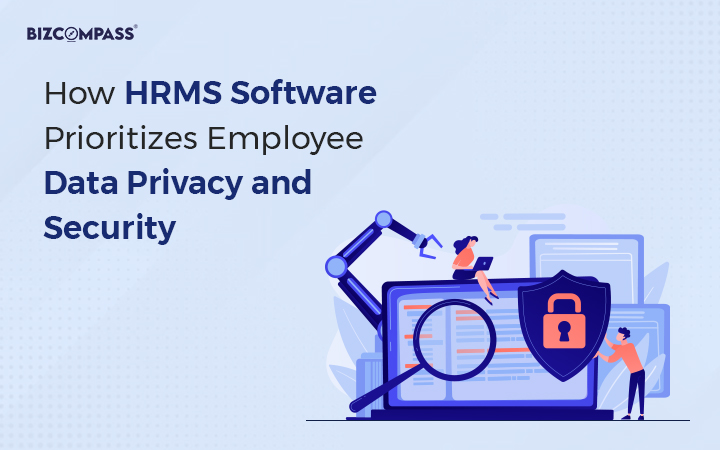
 >
>
